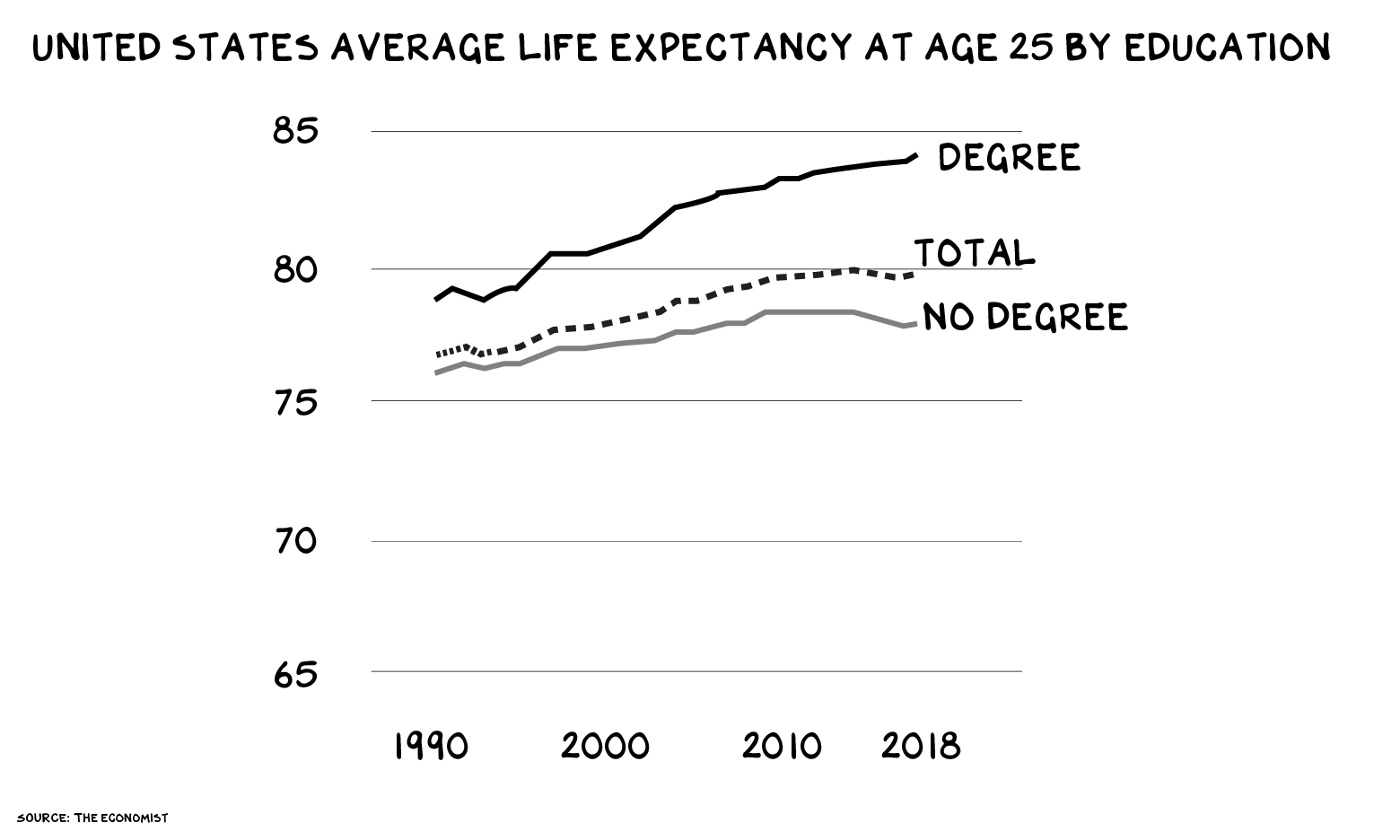
Higher Ed 2.0 (What We Got Right/Wrong)
Higher education is the most important industry in America. It’s the vaccine against the inequities of capitalism, the lubricant of upward economic mobility, and the midwife of gene therapies and search engines. College graduates lead longer, healthier, and more prosperous lives. University research provides the raw material for corporate innovation. Our institutions call to our shores the best and the brightest from around the world, many of whom stay to make America a stronger nation, and form connective tissue with their home countries.

Higher ed presents a promise for America and the world. But every year, my industry falls further from that promise. The underpinnings of that view are simple and static: Higher ed has increased its prices by 1,400 percent since the late 1970s, but the product has not appreciably changed — the biggest cost driver is administrative bloat. And, rather than catalyzing economic mobility, U.S. higher ed is stifling it. At 38 of the top 100 colleges in America, including five of the Ivies, there are more students from the top 1 percent of income earning households than there are from the bottom 60 percent.
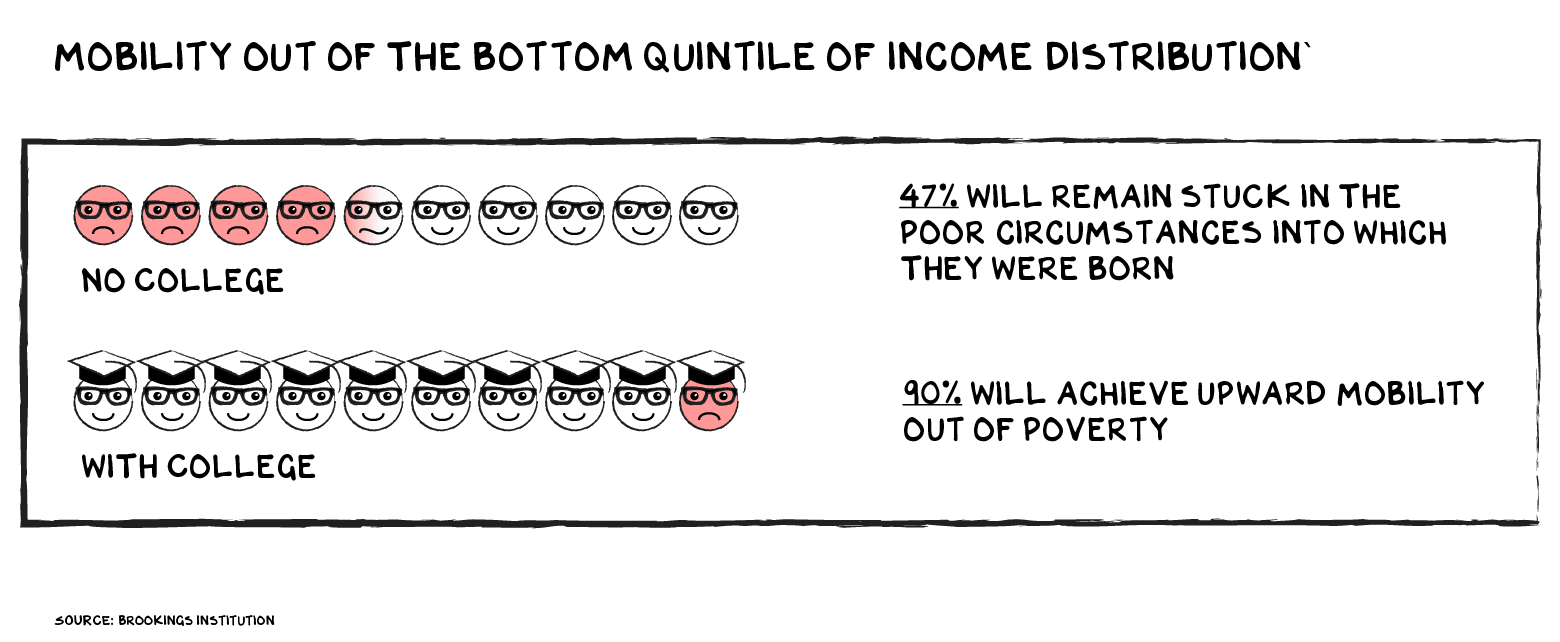
Yet, higher ed’s brand strength (nobody donates $20 million to name a building on Apple’s campus), cash reserves (among elite institutions), and stranglehold on the American psyche have insulated it from disruption for decades. The litmus test for success — and for determining your role in our species — is if (and which) college your daughter graduates from. Suzy might be a heroin addict, but if she’s at Dartmouth, all is forgiven.
Last year, we predicted the pandemic would be the fist of stone that finally meets higher ed’s glass jaw. Were we correct regarding the coming storm? Or were we alarmist, underestimating institutional strength (or rather, inertia)? The answer is … yes.
K-Shaped (College) Recovery
As we begin to emerge from Covid-19 (God’s ears), American colleges look like the rest of America. Specifically, the fifth installment of the Hunger Games franchise, wherein our society engages in the idolatry of economic winners, everyone else hopes to survive, and many meet a gruesome end.
The most selective schools received 17 percent more applications than last year, and the elite of the elite saw even greater increases: Yale, 33 percent; Harvard, 43 percent; MIT 66 percent. The rich are getting richer.
These schools (and the media) have emphasized that the increases in applications include record numbers from poor students and students of color — at UCLA, for example, overall applications rose 28 percent, but the school received 48 percent more applications from Black students. The result is that top schools are reporting their most diverse cohort of admitted students in history.
Two factors drove these increases: dropping the standardized test requirement, and the increased attention paid to racial and economic justice over the past year. Few people are in a position to make as immediate and tangible of an impact on the lives of promising young students from disadvantaged backgrounds as are elite college admissions officials. In 2021, they leveraged this power.
Widen the lens, however, and this trend starts to look less encouraging. Admission to a top school can be life changing, but in a country that graduates over 3.5 million people from high school every year, the 1,700-person freshman class at Harvard is immaterial. Over the past 30 years, the number of seats at Ivy League schools has increased only 14 percent, while the number of high school graduates has expanded by 44 percent. The Ivy League sits on a total endowment of $140B, and shares this wealth with just 17,000 freshmen each year.
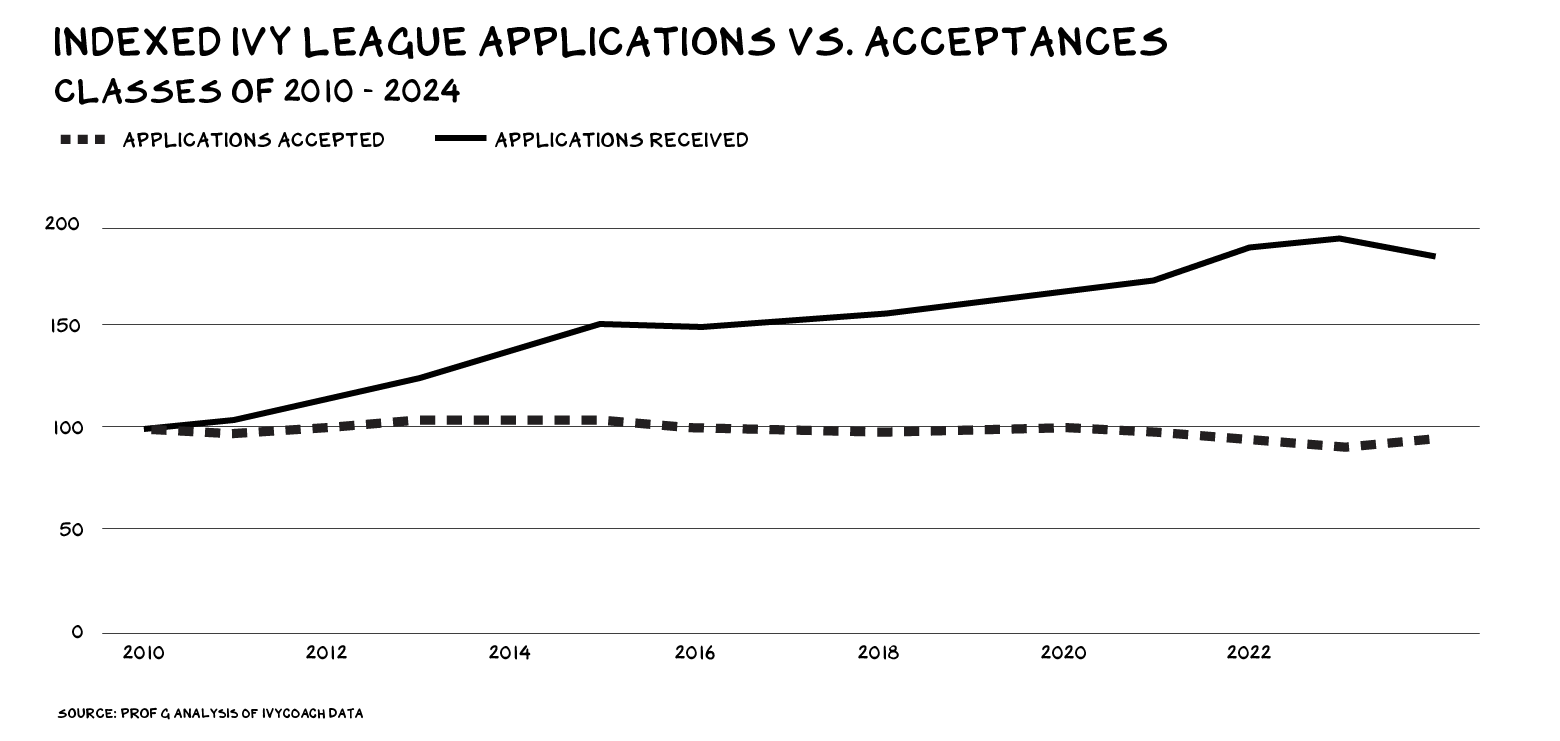
A year ago, I predicted that these schools would leverage their extraordinary brand strength and the forced adoption of distance learning technology to partner with big tech and radically expand their class sizes. “In 10 years,” I told New York magazine, “it’s feasible to think that MIT doesn’t welcome 1,000 freshmen to campus; it welcomes 10,000.”
I was wrong. The leadership and alumni of elite universities continue to register tremendous psychic reward from the Hermès-ification of their institutions, versus any remaining claim of public service. Expect another round of undue self-congratulation from these schools in the fall — but look closely, as the anticipated record-setting enrolled student numbers this year simply reflect the record number of deferred enrollments last year.
Zombie Schools Walking
Widen the lens a bit more, and the picture gets worse. While applications were up at elite schools, they were way down at second-tier schools. Applications for federal financial aid are also down 9 percent, which suggests that college ambition among poor and working class kids is declining. In a society where college degrees are the vaccine against inequality, this is disturbing news. Declining college attendance among those who would benefit most is a contamination of the vaccine supply.
The prediction that generated the most controversy we’ve inspired (with my shirt on) was when we wrote in April 2020: “We’ll see a culling among universities … we’re going to see dozens, maybe hundreds, of universities not reopen.” And we named names. In May, we predicted: “There will be a lot of zombie universities. Alumni will step in to help. They’ll cut costs to figure out how to stay alive, but they’ll effectively be the walking dead.” Within 72 hours I received my first, second, and third cease and desist letters from universities we said were likely to perish. The threats of legal action have tempered my actions and caused a number of sleepless nights. The last sentence is a lie.
So far, though, there has not been a rash of post-pandemic college closings. Some schools have closed: MacMurray, Mills, Concordia, and Holy Family, all small schools with long histories and proud traditions — but also financial weaknesses that left them exposed to the pandemic’s impact.
Many more schools have similar weaknesses. One study found that one-third of private colleges are at “high risk” of financial failure. (The study was never formally released, however, thanks to cease and desist letters from many of those schools … #feelyou.) Covid-related costs, coupled with the decline in applications, portend more problems. Many of these schools will graduate more Hunger Games contestants, but the odds are not in their favor.
Bankruptcy, as Hemingway observed, happens two ways: “Gradually, then suddenly.”
Wildlings
While the lords of American higher ed fortify their walls, and the erasures of second-tier castles multiply, there is a gathering force about to ignite a fire the North has never seen. Last year, I believed the change would occur on the supply side, with expanded enrollments at the top schools. It now looks as if the demand side will change the game: Employers are rethinking certification.
From Elon to Apple, some of the most admired employers are dropping the college degree requirement from more and more jobs. Over 130 companies have committed to accepting Google-certified courses as equivalent to credits earned at traditional four-year colleges. More than 250,000 people took Google’s IT certificate program in its first two years — and 57 percent of them did not have a college degree.
Similarly, Amazon announced a partnership with Lambda School, launching a nine-month, full-time training program in software engineering, designed to put graduates in jobs with an average base salary of $80,000. Students are not obligated to pay anything upfront; instead, they pay based on their salary after graduation. Again: no college degree required.
Here in Florida, Governor DeSantis has proposed using $75 million in federal Covid relief funds to invest in vocational training programs. There’s a scarcity of skilled tradespeople, and those are good paying, secure jobs — it will be a long time before robots replace electricians and plumbers.
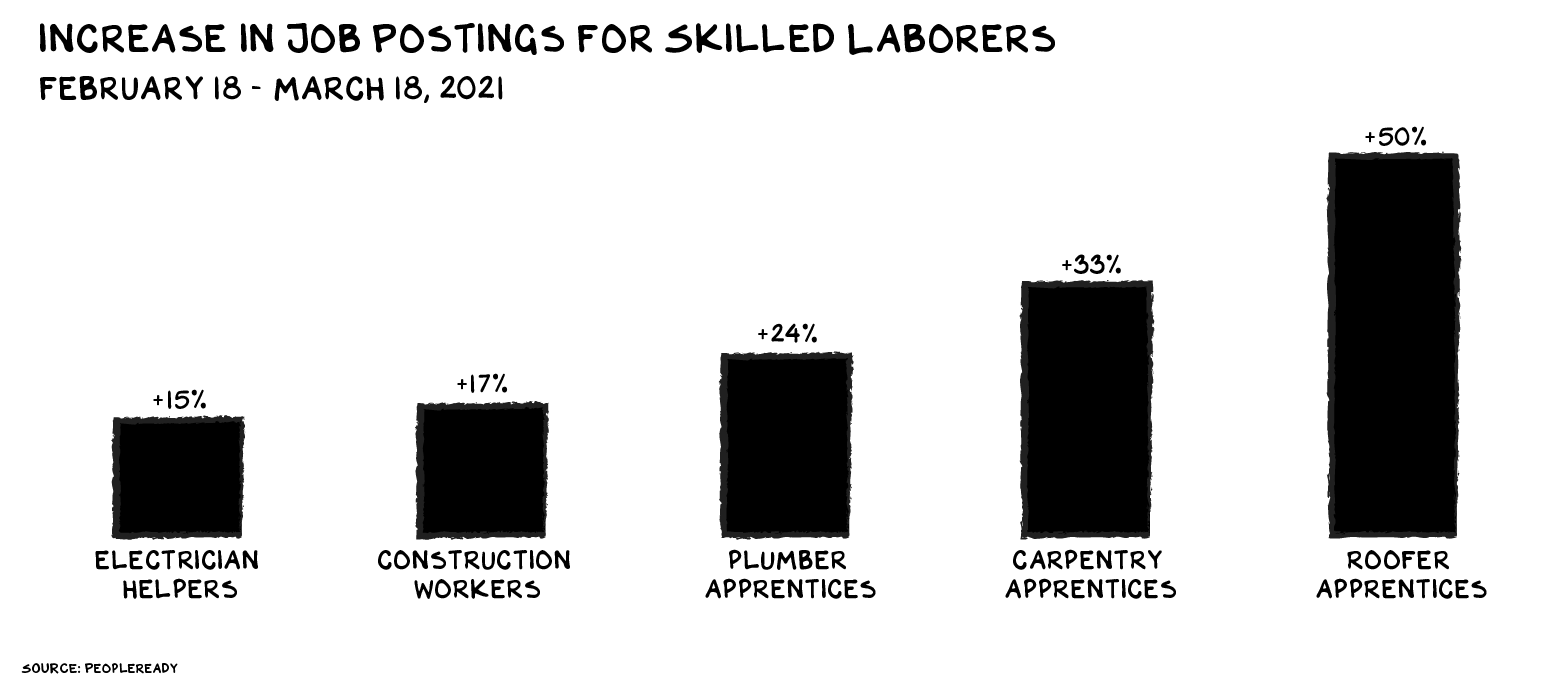
This is bad news for schools without the global brand equity of the elites. They are being unbundled, piece by piece, just as newspapers were dissected (classifieds, movie listings, news, sports) and sold for parts to benign billionaires. Today, we have a handful of elite newspapers that are thriving, a wasteland of dead/dying second-tier papers, and a roiling maelstrom of tech-enabled news sources serving the mass market. Since 2004, two thousand newspapers have shuttered. It could be as bloody among universities.
Break It All
As bad as this looks for America’s second-tier, four-year colleges, it may be great news for America. This unbundling presents the opportunity to break the wheel of four-year college dominance over the American Dream.
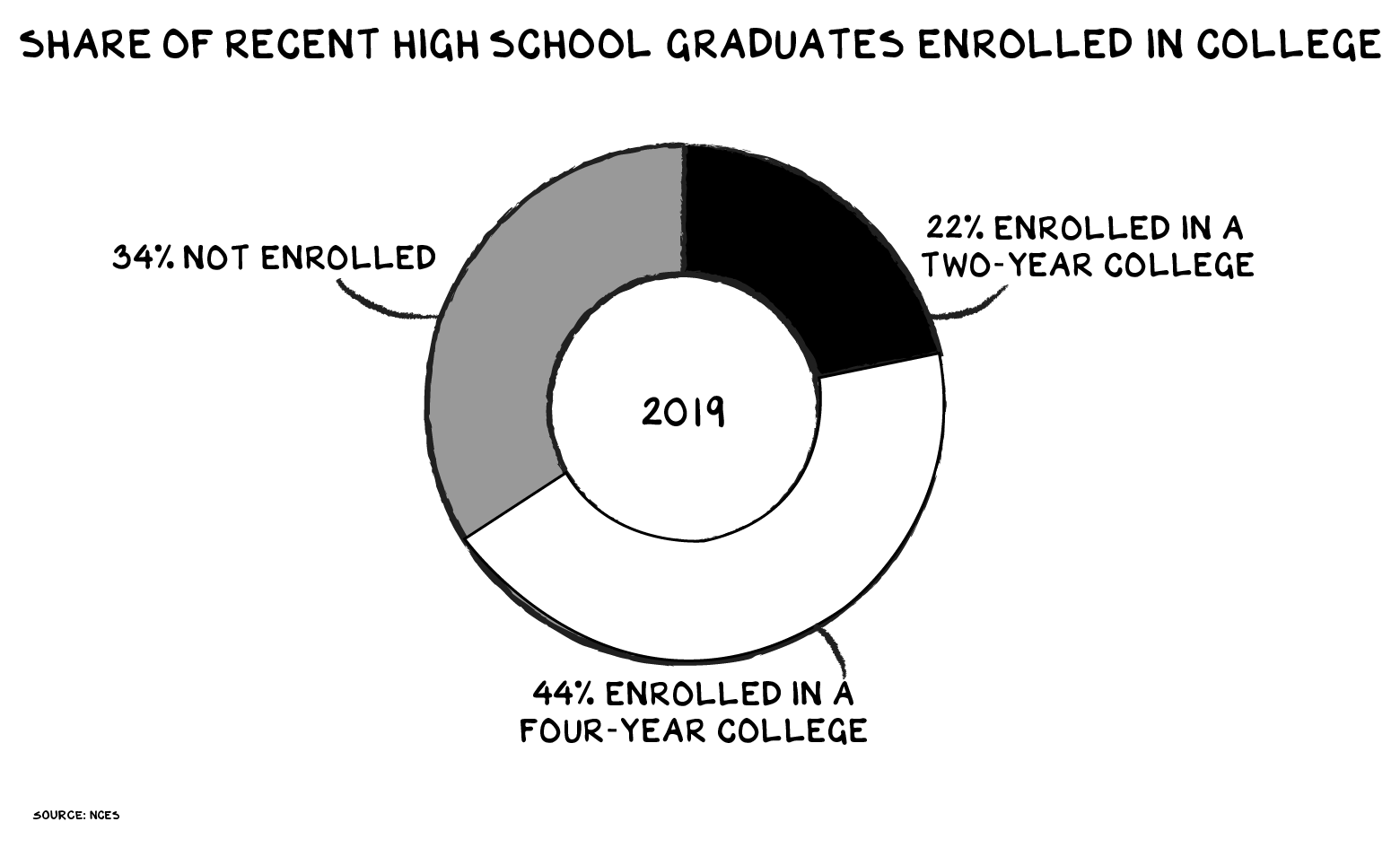
That dream itself is at risk. Wealth is being hoarded by the old, which has left young people adrift and unattached. We need to find ways to invest in the non-college bound, and create on-ramps into the corporate economy without the ritual of a $200,000 college education.
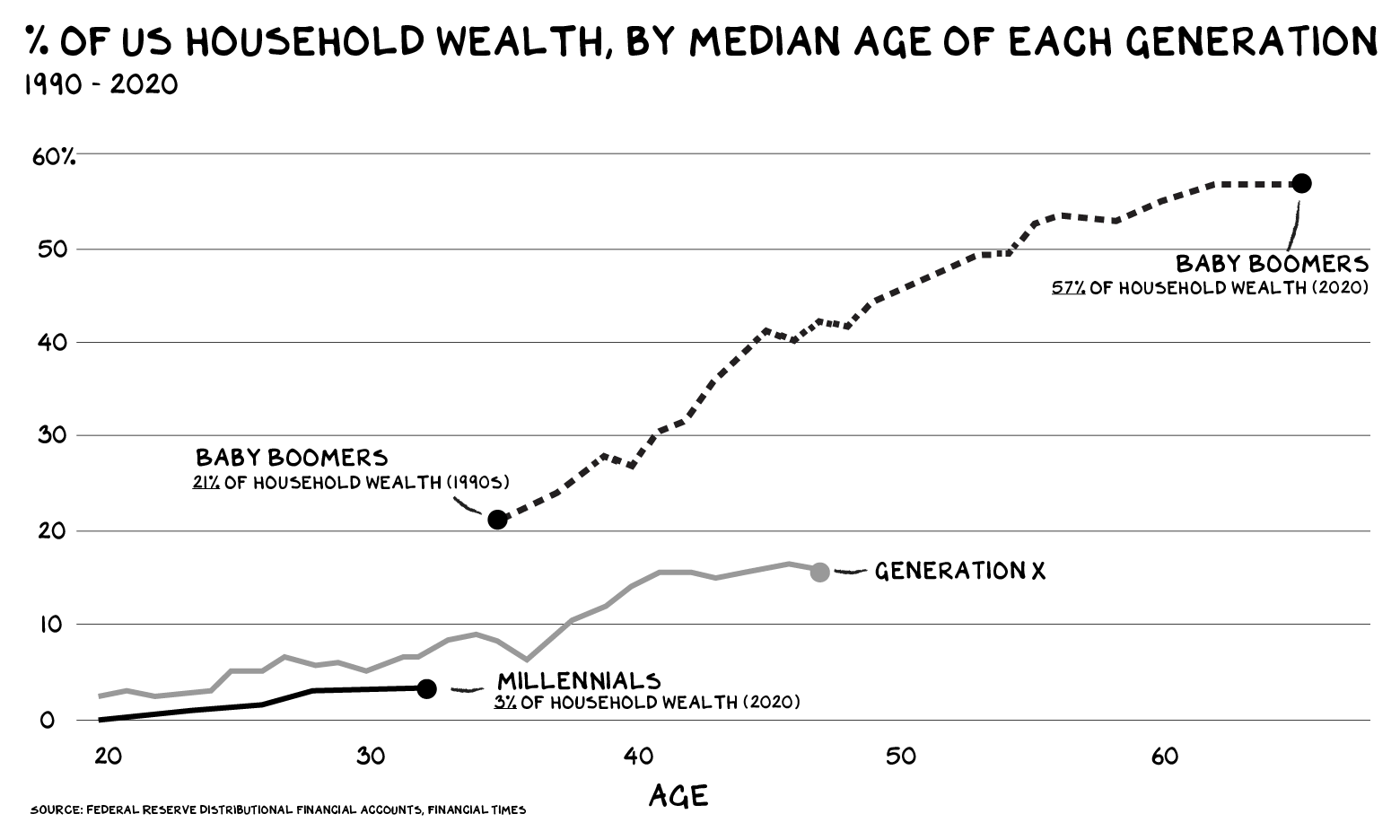
These programs could also liberate education from its ageism. College is the most ageist sector in the U.S., a huge industry set up to serve 18-24 year olds. Even graduate schools are designed to appeal to twenty-somethings. Yet our innovation economy means people will need new skills at every phase of life.
One lesson can be taken from universities, though. Just as they dropped the requirement of standardized tests, and registered enormous progress around diversity and inclusion, America can register the same unlock if U.S. corporations broaden the on-ramp to a better life by dropping their fetishization of the college degree.
Life is so rich,

P.S. A hero of mine joined me on the Prof G Pod this week — Senator Al Franken. Franken discusses the state of play regarding our political ecosystem and how Americans are separated into two different information universes. He also shares how he got his start in comedy, as one of the original seven writers at Saturday Night Live.
61 Comments
Need more Scott in your life?
The Prof G Markets Pod now has a newsletter edition. Sign up here to receive it every Monday. What a thrill.


While I believe these other avenues for education are a good thing for peoples employment opportunities they lose out on learning about diversity of humanity. I treasure the friendships I formed in college with people that were not studying to be engineers or were from other countries.
Inequity is not a feature of capitalism. It is a feature of human existence. Please stop acting as though Marxism is the solution to everything. Have you ever heard of a little place called the USSR?
Polio is a “feature of human existence,” friend. Should we condemn Jonas Salk for tampering with nature’s grand design?
There is one part of the narrative both in this blog and in overall news is our culpability in the rise of higher ed–namely voting Republican during the 70s and 80s at state levels. States under Republican leadership during that stretch kicked the defunding of at least public colleges and universities most positioned to help the middle and rising classes into high gear. As the need for tuition dollars was a consequence, so too did the rise in services (i.e., admin overhead) to compete. Similar to what Kaleberg is saying.
Great read! I believe if the government stops issuing loans then the effects of free markets will kick in. Corporations may then drop their requirement for a college degree or might offer a work/study to high school graduates where they may be willing to fund the student’s college education instead of paying them.
“Administration Bloat” – at every level of education is a huge financial increase! Please dig deeper into that. Yes, Administration provides jobs, but are so many Admin jobs needed? Thanks, great reveal as always.
Hemingway. NOT Hemmingway. He was never known to hem or haw.
About 1/4 of all college students attend private colleges. The rest go to public colleges, but public colleges, like almost everything with “public” in it, have been systematically starved for decades. There are about 20M college students in the US. Assume that ten Ivy League colleges each with 10K students double in size. Instead of 4.9M college students in non-Ivy private colleges, there would be 4.8M. I don’t think this would have much impact on the college admissions problem. No, the internet isn’t going to solve this by allowing a much higher growth multiple.
I don’t think we are going to get rid of the college advantage. The big driver has been a declining need for labor to provide the necessities. As farming employment collapsed in the late 19th century, you really needed a grade school education. After the Great Depression in the 20th century, you really needed to finish high school. Then manufacturing employment collapsed, and as 2000 approached, one really needed a college degree.
As faculty at a 4yr college (STEM field) I have to laugh at the comments here about faculty salaries. For those unaware of what is driving up costs, I would recommend Ben Ginsberg’s book “The fall of the faculty, and the rise of the all administrative university” (https://www.amazon.com/Fall-Faculty-Benjamin-Ginsberg-ebook-dp-B005CU4TPK/dp/B005CU4TPK/ref=mt_other?_encoding=UTF8&me=&qid=). The driver of high costs is the proliferation of Deans, Provosts, Vice Presidents, Senior Associate Deans, Associate Vice Assistants to the Provost, and Senior Vice Assistant Directors of Presidential Affairs. Every campus now needs a Communications Director, a slew of Diversity and Inclusion Officers, and entire Office of Global Engagement. And of course each of these offices, once established, lobbies for a vice-presidency and expansion of their ranks. And of course with COVID, now we have to have more IT people, whole teams of online learning support staff, a whole cyber-security office. Not one of these people ever teach a class.
AND, while the admins continue to grow their ranks and pay themselves handsomely, the faculty are gradually being replaced by insecure adjuncts for teaching most classes. Just to get real here – an adjunct (usually with a PhD in the specialized field) will get paid ~$3k for teaching a 4 credit course for 1 semester (that’s 4 contact hours per week, plus a 2 hr. lab, plus grading, prep, office-hours etc, so about 15 work hours). If they can teach a couple of classes per semester (usually at different colleges, with travel not reimbursed), they can pull down a grand total of $12k a year, pre-tax, with no benefits. NOW do you understand why tenured faculty hold onto those coveted spots so fanatically?
For the tenured faculty who are lucky enough to be at a research-heavy institution (as I am), it gets even better… We’re expected to cover 60-80% of our salary from grants (from NSF, NIH, etc.) At some schools it’s as high as 90%. Every grant dollar we bring in comes with another 50-60 cents of “indirect costs” that are supposed to pay for infrastructure to support the research, but in reality it all just disappears into a black hole in the Dean’s office and gets used to pay the other 20-40% of the faculty salaries. So effectively, it costs the University precisely zero to pay people like me because 100% of our salary is covered by federal grants. Meanwhile many of us have not had a pay raise in 5 years, and when we do it’s a measly 1% cost of living increase. But hey, several of our top admins pull down $1-2m/yr, so I guess all is fine.
Forget disrupting education, I want disruption of the educational administrative classes. First tech’ co. that figures out how to replace Deans and Provosts with robots is gonna be a winner!
Well articulated and I am in agreement.
I can’t speak to the university poor Virgil teaches at but in the two-year public sector world; we are not overrun with administration, faculty are paid out the general fund budget and state funding -once are strongest source of revenue – is our weakest and least predictable funds source. Accreditation and state/federal regulations drive the increase in administration. It’s oversight on steriods.
So, while as a former university prof, I’m sympathetic to the Virgil’s of the world, running a higher ed instiution is more complicated than it looks.
This was so effing right in so many ways. I wish I could shake your hand.
Tesla gave rich people an expensive electric car to buy. Ivy league schools give expensive schools to go to. The schools are going to always be expensive because their customers want to pay the more for something that looks better.
Bloated management in universities is frequently driven by the academic side under the guise of “academic freedom”. Justification for treating classrooms as fiefdoms and not shared infrastructure, technology as ‘special to our needs’ leaving duplicate IT departments, incompatible productivity solutions, multiple facilities departments, etc. The creativity of individual colleges within universities is as boundless in duplicating overhead as they are in resisting change.
It would be sad if universities followed the path of print media, but that’s what they might do.
The Internet disrupted print media in a few ways. The one we all talk about is Craigslist and other sites stealing the ad revenues that print media depended on. But the Internet also gave print media’s top performers new distribution options, making them harder to hold.
If higher ed sees competition from skills courses and new certifications, it may also see its best professors take their acts outside of university walls, weakening the draw of even elite institutions.
The big media brands seem to have responded to the Internet’s threat by focusing on specific market segments. For general news, the segments seem to be sliced according to political sympathies. So we have Fox, CNBC, NY Times, Wall Street Journal, WaPo, etc., all increasingly serving political echo chambers. What if the universities do the same? I’d bet on this happening.
re: Gov. DeSantis and the Florida legislature are banning the use of state funds for membership fees going to orgs that cause a
“negative impact to the state” as a response to NCAA voting FOR trans-sports, and Florida banning trans-sports, with possible NCAA retaliation against Florida.
Accreditors are also paid with state funds, but now the quasi-federal arbiter of education quality in Florida is effectively prevented from dropping recognition of any of Florida’s schools, making accreditation meaningless. LOL!
I earned a four year degree in commerce after high school and then completed an MBA part time in my late twenties. I work in corporate lending and absolutely use what I learned in formal education.
Accounting/economics/finance 101/201/301 are very important if your are deciding whether to lend a company millions of dollars. Yes, I could have bought textbooks and self studied the material but that takes a LOT of self discipline and is also less efficient. If I am in class and have a question I ask, get the answer, learn on the spot, and move on. This is how the corporate world works – if you have a question you ask a colleague or your manager and they provide the answer or where to find it. If self learning I could spend an hour trying to find the answer to a simple question.
Another challenge with self learning is you don’t know what you don’t know. Or it may be difficult to find material on more niche topics.
Small class sizes are key to high quality education – where there is interaction between the professor and other students. Does this need to be exceedingly expensive? I don’t think so.
I love Galloway, and hope that he returns to this topic on an annual basis, following all its twists and turns.
No mention of credential inflation (yet …) when it comes to unnecessary graduate degrees. Never heard of credential inflation?
http://sociological-eye.blogspot.com/2018/07/educational-credential-inflation.html
Education costs are growing, and are already $1.6 trillion (not including all the shadow debt, PLUS Loans, cratered retirements, etc.), and will eventually gobble up the GDP entirely! This is where President Joe wants to take us — upward spiraling credential inflation — because only a Masters degree counts now. Forget about the BA or BS. Now it takes a Masters degree. (Assuming there are any entry level jobs left … after Covid.)
I am not sure how you got from four year colleges cost too much (agreed) to the point that students are choosing community colleges instead and colleges are in crises. You cite the lessening of college requirements by tech companies for devs as a sign that college is losing its importance. Most people are not choosing to go to a four year college to learn how to do one thing for the rest of their life, which is not the point of that type of college. Even my Dad, who went from a retiring as a vet to retiring as a a Dean at a community college understood the difference. He expected all of his children to graduate from a four year college because it expands your mind and teaches you critical thinking skills, which even for a software dev, would be helpful for the long haul.
Your link about Desantis says he diverted $40M from the Fed, but even at $75M total, with 300K students, that’s $250 per person. With President Joe Biden’s American Families Plan, he is appropriating $109B for 5.5M students, which is $20K per. That is a game changer.
One hypothesis is that the availability of almost unlimited capital has distorted the market for education and in part enabled the high cost and lack of innovation from these institutions. I fully support the idea of the funds but more free money may only delay the inevitable and will not drive change.
Your ageism comment is interesting in that you chose to focus only on the students. Exactly the reverse-ageism form of anti-competitive monopoly is at play in the ranks of faculty. As if protected for life by tenure wasn’t sufficient, state univ faculty get state taxpayer funded pension plans in addition to their 403(b). Faculty salary inflation at the top public universities, particularly in STEM and business fields is unlike anything seen in the corporate world (expect at the CEO level), and yet there is no reporting on this at all (because, well, who would do THAT research eh?). This stifles the pipeline of younger professors and researchers who would be significantly cheaper. Oh, and then there’s this – in this America of ageism – try landing a corporate job if you’re near 55-ish – tenured uni professors have decided that there is no mandatory retirement age! Wow. And these fuddy duddies lecture us about the magnificent benefits of disruptive capitalism? Why is nobody talking about this?
Wow. What state university are you talking about? I see nothing like what you describe where I live.
I agree with Mr. Irving.
Hemingway. NOT Hemmingway. He was never known to hem or haw.
Believe it or not, the easier it is to get financing, the easier it is to sell something and that’s the main driver of higher education costs. If we want more of our children to be successful, we have to do much more in grade school to see that children don’t fall behind and really get a good quality basic education. That means putting our best teachers and more money in those areas at the start of the education system then supporting those students through their journey.
Let’s face it, our brightest and truly gifted children are not going to generally have trouble finding success in a country that offers freedom in career choice and is honest in letting the student know that an art degree probably isn’t going to generate a living wage.
Great article.
As a medium sized tech employers and a believer is higher ed (NYU Stern grad..) After 20 years of requiring a college degree, I’m dropping the requirement from my entry level positions if applicants can display the hard skills needed for the job. With the rise of alternate ways to learn, coupled with the extreme cost of colleges that are turning as much into closed minded, liberal/woke indoctrination camps, I’m looking into alternatives for their “product.” This also includes developers in other parts of the world – India and Costa Rica, that are available for a fraction of the cost and without the entitlement of many of today’s graduates.
Big fan of your writings and pods. We both went to Uni High & UCLA. I think the 4 year college model is eroding because parents and students have realized that colleges do a terrible job preparing kids for the real world. Now you may argue that that’s not the responsibility of higher education but I’d say this. My daughter was ‘forced’ to take calculus in college as one of her prerequisites. She struggled thru it. Nowhere is her adult life will she use the knowledge but, had her liberal arts college taught a class called Life 101where she could have learned investing, the art of connection, how to sell oneself, how to ask for a raise, etc etc, she’d have the tools to be a more full functioning adult. I’d even offer that colleges should offer a class in mental health and taking care of one self. The biggest benefit of both my kids education was getting out of the bubble they grew up in and meeting kids from all walks of life. And while I think that is so important, it shouldn’t be a 4 year hundreds of thousands of dollar experience.
Hi Scott, What you have missed is the deteriorating quality of college education. Much of what is now being taught is useless guff that only serves to provide high paying jobs for the university staff.
No wonder the vocational skills uptake has risen.
Young people have woken up that you have to be useful to earn a living!
Good perspective, as usual. Two points, however…
1. The elimination of standard test, at least at the UC system, will be the downfall of the best public university system in the US. The requirement will now be ‘diversity’, and quality HAS to suffer. The key reason for the change was NOT fairness, it was that Cal politicians, sports heros, and entertainment types couldn’t get their low performing kids into UCLA. In the past, they would pull a ‘Kennedy’ and endow a chair. Now, there are too many ‘Kennedys’ in Cal and too obvious when they try to buy an entrance. Ivys expect it, but UCs do not. UCLA is about half Asian not because of racism, but because of the work ethic and family priorities. When the priorities become cool sports shoes and which party drug you can hijack from your dad’s stash, UCLA is doomed.
2. You show the standard charts, life expectancy and such, for college grads. That is beneath you to use such simple stats. Break down the attributes by choice of major say business, STEM, and liberal arts. Or by school. And, for non-college stats break down by minimum wage retail job vs trade/vocation job. That girl with the Masters in FemLit is more likely to make minimum wage than the one who becomes an electrician or Imaging Tech.
Totally agree with your points on college and love the similarities and comparison to vaccines. I’m super passionate about financial freedom and graduating college without drowning in student debt is definitely a huge move. I recently joined a young professional board for a non profit, Moneythink, who came out with a slick free app to allow high schoolers to easily compare their college choices and award letters. Actually breaking down loans vs. grants vs. work study. No bs. Decided.org would love your thoughts.
The federal government needs to disassociate itself from college loans. The universities should underwrite student loans, and be at risk for their payments. I’d support an act that forgives all current student debt in return for the federal government terminating it’s guarantee of student debt.
Say goodbye to any curriculum that ends with ‘studies’.
I agree, but schools cannot have ‘diversity’ and not have ‘– Studies’. Where to put the ‘diversity’ Freshmen? Too many non white or Asian kids are discouraged from education by media stereotypes that SELL something. Malt liquor, shoes, fake nails, wheels for your truck, something. If you are smart and study, you will be shunned. If you are trying to get ahead, even much of your family will turn on you. I have seen this in the classroom first hand. Best way to change is for NBA stars to do a lot of PSAs about school and learning. But, they need to subsidize there $10M/year salaries by endorsing shoes, no time to help the community.
On one hand you declare that “Higher education is the most important industry in America.” Some would say that food and housing are more important industries. After you elevate higher education you say that corporations need to end the fetishization of college degrees. ????
Scott,
I believe you are correct about forecasting the forth coming demise of much of the higher education industry but your timing is off.
Universities and colleges have no reason to slow the growth of the spiraling cost of a four degree as long as the nearly boundless supply of eager freshmen is made possible by the sundry governmental programs providing below market financing for their product.
However at some point the limitless supply of freshmen will begin to contract. Then the blood bath will begin.
When is the question: Two years, five years, ten years, who knows? FWIW, I’m betting closer to ten years than two years.
Thanks for this thought provoking article. The Federal stimulus money has provided a backstop for many colleges and there are some that are coming out of the pandemic financially stronger than before it started.
33 years as an engineering professor here. We really need a revolution in not just understanding WHAT we do, but also understanding what knowledge actually is. Knowledge is created in communities (rarely by an individual) and the interconnections inside that community are the things that both create synergistic understanding, as well individuals that can master that complexity. Even more important is understanding whether WHAT we are doing is developing agency and the capacity for independent action.
These are big things, because they impinge directly on our blind spots — things professors’ brains just don’t understand well at all. Those blind spots come from our social structure, which really is the thing that evolves our thinking (or not) and in the academy that means status-seeking, rigid, hierarchical thinking.
Understanding that these are larger memetic patterns is what I do. If you’re interested, read this post. The memetics of information creation haunts all that we do, like it or not. Because we really are in the Matrix. And this post is the outline of its principles. https://empathy.guru/2019/04/06/what-is-structural-memetics-and-why-does-it-matter/
When I was a graduate student I was elected the student representative from my department to the faculty and as such I attended most faculty meetings. What Chuck Pezeshki says in his post is exactly what I heard from the professors there, esoteric discussions like the one brought up here on “understanding what knowledge actually is.” Never once did I hear a discussion about learning or even the students who are indirectly providing their paycheck. Not to mention the number one taboo subject, teaching. I think undergraduate students would be horrified to know that their professors don’t even think about them at all.
Disagree that understanding what knowledge is is esoteric -it’s actually key – hope you read the piece. Agree that we don’t talk about learning hardly at all. Here are some thoughts written on the MIT debacle that might help. We’ve got structural problems. https://empathy.guru/2019/09/08/why-must-academia-evolve/
“the biggest cost driver is administrative bloat” – that’s a symptom, not a cause. The driver is a symbiotic relationship between colleges, banks, and politicians. Politicians at all levels can, when getting elected, throw in that they’ll help make college more affordable. They do this by leaning on banks to make loans more readily available (kinda like they did with mortgages). They accomplish this by telling banks that the govt will pick up the tab if the loans go bad. So banks, who can now loan out money without fearing default, loan money with nary a whisp of underwriting diligence. The loans are zero risk to the banks, so they’ll load the students up with debt. The govt looks like it’s helping by backing the loans, but they’re backing the banks, not the students. The students can no longer discharge defaulted loans in bankruptcy, so the debt follows them forever. The colleges, knowing that students MUST get a degree as table stakes to join the (dwindling) middle class, have no disincentive to raise tuition through the roof. Colleges even start competing for student loan dollars by building fancy student centers and amenities, which serve to justify/rationalize the higher cost. Ever notice that even lowly ranked private universities cost an arm and a leg? This isn’t some grand conspiracy. This is just a dynamic that higher education has evolved into and involves an unwitting confluence of mutually exacerbating forces.
Great piece Scott! I am self taught-no degree-and have started and run my own businesses. I also have experience working with high school and university students in New Haven, CT. The kids in high school in the inner city are struggling to find a career path which even in the Community College system is beyond their economic reach. I mentor some of this kids and have hired them as paid interns-in my opinion we should do what we can to level the playing field and bring back apprenticeships in some form.
This is the third time in the history of this blog that you’ve written the words “I was wrong.” How are you holding up, sir? I hope all is well 😉
I like to think there are better examples than Lambda School of employers partnering with independent certification providers
https://dfpi.ca.gov/2021/04/26/lambda-school-reaches-settlement-with-dfpi-agreeing-to-end-deceptive-educational-financing-practices/
As a college educated person from an elite institution – there is a view, we got in, we have the degree, we must not dilute its value. The bigger picture is how we enable more to attend our best universities electronically and less expensively.
I do struggle with how enable more Americans to participate in learning at our great higher education institutions vs enabling global access in a flatter more competitive world…
Do you feel that way or does the school? I could care less if enrollment doubled, probably cuz Cornell isn’t elite right? There are like a handful of weird areas that students would be genuinely worse off from (getting an IB interview but guess what they’re recruiting at Big 10 schools instead!) and in those areas I’d say they’re better off from more competition and inventiveness.
I should have waited:
https://lambdaschool.com/the-commons/update-lambda-school-team
“About an hour ago we held a company All Hands where I announced that we are laying off 65 Lambda School employees as part of a restructuring. I started Lambda School to create jobs and opportunity, which made the decision to make these changes very difficult. We will be saying goodbye to many incredibly talented friends and colleagues, and today will be even more difficult for them.
We’re trying to do something that hasn’t been done before – prove that an accessible, incentive-aligned education model can work sustainably for all students willing to put in the work. Lambda pioneered the income share agreement (ISA) in the career and technical education space, and we’re now watching many of the schools who followed us abandon their ISA offerings because they believe it’s impossible to make this model work.
We strongly disagree. In fact, many things at Lambda School are working very well, and we believe we’re on the path to proving this model successful and sustainable. We have a few remaining operational challenges to work out, and today’s restructuring and right-sizing are a part of creating the time and space to address those challenges and build the future.”
One smart guy.
I think you miss the point entirely on what the value of a college degree actually is — it is the pedigree and rarity of the program, not so much the “education” itself. A top flight degree is valuable primarily for a couple of reasons: first, it serves as the HR department for the world’s corporations. A person that gets accepted at a top program is signaling their top quality and hireability — the education is largely irrelevant. Second, it confers a marketing advantage on companies that have these people on staff. This is why your absurd idea that 10,000/year will ever graduate from MIT is, well, absurd. The MIT admissions department understands this much more viscerally than you do, apparently. The admissions departments of ivy league schools serve the same purpose to education as the De Beers Group serves to the diamond industry: to make something largely bogus and valueless appear valuable and rare.
The product of American institutions of higher education is largely a scam perpetrated on the youth of the country (and their parents), with the help of the financial industry and the government. An education is a beautiful thing. $100,000 in debt and requiring a degree to get a $25/hour dead end job is not.
Is it a thing of beauty to have a ‘elite’ school degree in something totally useless, a minimum wage job, and that $100K debt (more like $400K)?
How would you define elite?
Al Franken guest spot was terrific. Don’t just love him because I too am a DeadHead, his POV on the GOP establishment is spot on.
Excellent points. In addition to disruption help to relieve students of the debt caused by the current system what would those of us who paid the tuition have done with all those funds?
Question: why don’t the private institutions with $140B under management pay taxes?
Because they are not for profits.
Gawd, you drive me crazy right outta the chute. Inequity is a virus that needs to be cured? Seriously? Capitalism must create inequity. It’s part of the system. It’s why it has been the greatest (by far) system for the creation of wealth in the history of mankind. That wealth can be redistributed, but please; give me more inequity!
Exactly! If equity is what matters most, say goodbye to mobility, creativity, motivation… And also: government (Obama regime) involvement in loans, increasing the caps, decreasing private market participation has a piece of the blame of rising costs. Not something big guvment people want to discuss.
And finally, if I follow you: higher ed works, higher ed is good… and, last paragraph, we really don’t need higher ed much. I can’t disagree… People don’t generally NEED college — but it’s undeniable that college is generally a waypoint on the gameboard of Life when well-played by a great many. Also, “higher ed” is not monolithic–the person selects a degree and is destined to achieve the station in life they are accustomed to no matter what school/degree – what is the quantifiable value-add conferred by the “good” schools over and above the “default glide path” of the student at the school? That would be interesting to see–which schools add value and which degrees?
Finally: so much of higher ed is being overtaken by virtue signaling and indoctrination – that is not a path that will lead to mo betta success for our students or for the schools…
“Inequity” unambiguously means injustice or unfairness. I imagine that’s why he chose that word. We want capitalism, but we want it to be fair (i.e. if you are smart and work hard, you can get ahead).
I think that “inequality [of capitalism]” would be more along the lines of what you’re describing, which—you’re right—would not make a lot of sense. If you eradicated the inequality from capitalism, then you’d be left with no capitalism at all.
Inequity means unequal outcomes. Injustice means not getting what you deserve. Unfairness means contrary to law or convention. In this context, it’s a poor word choice for someone that understands how capitalism operates.
Eye Opening!
On point.
But also important to note how much elite institutions leverage the brand strength through very lucrative executive eduction courses. Companies and participants over pay for a certificate from MIT or Harvard and for some of these programs even call themselves Alumni. But it’s the scarcity of the actual spots in their classes that preserves the premium brand. Not sure if they start opening it up too much it’s like Cadillac slapping their badge on a Chevy Citation back in the 80s…
MITX has courses online where you can take the same courses people pay big dollars for. But the signaling of the degree and the network are another thing. These institutions can do what they want but we continue to live in an economy where the particular skills are in desperate need regardless of where you went to school.
BINGO
I like the fact the writer is indicating more education would benefit our society. Our focus on college is so misplaced, we have so many folks drop out of high school, as well as, so many who never go beyond that level for a variety of reasons: economic, social pressure, lack of confidence. Can we focus just on these 2 groups since they represent a portion of our population that creates more pressure on using the limited resources of our social networks and less on their own abilities to move towards self reliance and contributions to society. Trade schools have seem to become a back burner issue in the discussions about improved education opportunities.